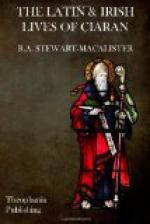No modern biography, no edition of the ancient homiletic Lives, of Ciaran could be considered complete without a history of Clonmacnois, through which being dead he yet spake to his countrymen for a thousand years. It was the editor’s intention to include such a history in the present volume; and this part of the projected work was drafted. But as it progressed, and as the indispensable material increased in bulk, it became evident that it would be impossible to do justice to the subject within the narrow limits of a volume of the present series. A slight or superficial history of Clonmacnois would be worse than none, as it would block the way for the fuller treatment which the subject well deserves. The materials collected for this part of the work have therefore been reserved for the present: it is hoped that their publication will not be long delayed.
[Footnote 1: The name is pronounced as a dissyllable, something like Kyee-raun, with a stress on the second syllable.]
[Footnote 2: The Bollandists long ago remarked as the special characteristics of Irish Saints’ Lives, their doubtful historicity, their late date, and their continual repetition of stock incidents. (At priusquam id agam, lectorem duo uniuersim monitum uelim; primum est, quod Hibernorum sanctorum acta passim dubia sint fidei, et a scriptoribus minime accuratis ac aetate longe posterioribus conscripta; alterum est, quod in iisdem frequens occurrat rerum simillimarum narratio, quas uariis sanctis adscribunt, ita ut nescias cui tuto adscribi possint.—Acta Sanctorum, September, vol. iii, p. 372).]
[Footnote 3: Even the date of Ciaran’s death may have been manipulated, in order to make his age conform to the age of Christ. As we shall see below, traditions vary.]
[Footnote 4: The end of the world is not actually mentioned in the Annals, but the expected plague referred to was undoubtedly the apparition of the mysterious Roth Ramhach, or “oar-wheel,” an instrument of vengeance that was to herald the end of all things. For the references to this prophecy see O’Curry’s Manuscript Materials of Ancient Irish History (index, sub voce “Roth Ramhach"), and the present writer’s Study of the Remains and Traditions of Tara (Proceedings Royal Irish Academy, vol. xxxiv, sect. C, p. 231 ff.).]
[Footnote 5: The following corrections may be noticed. Page 201 of printed text, line 7, for Et cum read Cumque. Same page, line 24, for factum read factam (sic). Page 202, line 6, after vitulum add ilico canis famelicus iruit (sic) in uitulum. Same page, line 25, after fregit add et fracto capite effussoque cerebro canis periit. Same page, line 33, after narrabant add hoc. Same page, lines 35, 38, for vaccam read vacam. Page 203, line 35, for Angeli read Angli. Same page, line 39,




